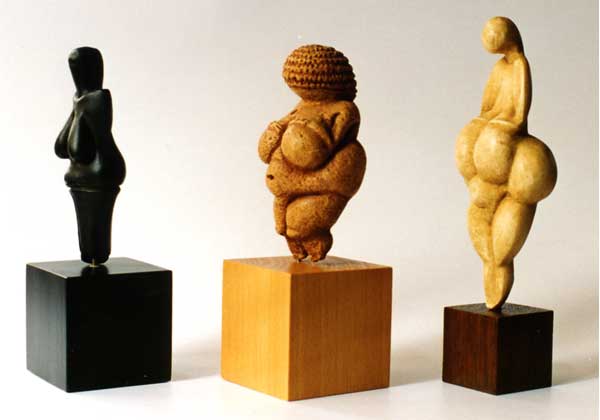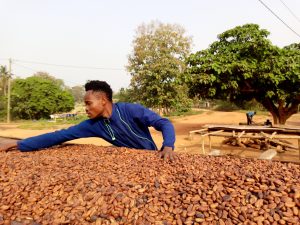Since the early stages of human life and prosperity, art has used by different societies to display their craftsmanship and to demonstrate their beliefs. Two types of artistic creations are the paleolithic Venus figurines from southern France and the bronze age jade figurines of China. These two art pieces contrast in both usage and symbolism. The figurines in the paleolithic, European era were made by hunters and gatherers, while jade figurines during the Bronze Age are part of an advanced civilization. Still, both provide scholars insight into the practices and goals of the people at the time.

One of the earliest forms of art includes the figurines from the European paleolithic era. Created by homo sapiens about thirty thousand years ago, they were called Venus figurines by scholars after the Roman goddess of love Venus, because they depict the body of a woman. Today, more than one hundred have been found and they all have similar characteristics. The figurines range in height but are on average 150mm tall. They are made from materials such as steatite, calcite, limestone, bone, ivory, and clay.1
Today we wonder about the meaning and purpose behind the faintness of facial features and hands in these figurines, yet we note the emphasis on the woman’s hips and legs. Although we do not yet have definite answers to this question, there are many theories available. One popular theory is that the societies that created these figurines had a deep interest in female fertility. Other theories mention their hope for survival and fear for extinction.2 A less popular and more controversial theory is the possibility that Venus figurines were self portraits.3 Still, different theories are necessary in order to better comprehend the motifs behind the Venus figurines and their crafters.

In contrast to the Venus figurines in Europe, Chinese jade figurines offer a clearer sense of the usage of art in the Bronze Age. Jade figurines were often buried with wealthy individuals along with their former slaves, food, jewels, and many other objects. Although the jade figurines took very long to make and were a process of hard labor, their symbolism of prosperity and luxury in Chinese ceremonial traditions demonstrate the practice of ancestral worship and how important it was to them. Because they believed spirits passed into another realm of existence, from which they had the power to affect future generations, tombs were lavished with tools so that masters might live plentifully along with sacrificed slave bodies that would continue to serve their master. For example, in the tomb of lady Fu Hao, wife of the Shang king Wu Ding, 755 jade carvings, 468 bronze objects, 130 weapons, and 4 mirrors were buried.4
Although prehistoric pieces such as figurines, cave paintings, and carvings are often overlooked because of the ambiguity of their meaning, they convey people’s emotions, ideas, and talents. Creations such as the Venus and jade figurines provide the world insight into the practices of our ancestors and the kinds of resource available to them. They serve as a timeline and teach us about their interests and abilities in eras as diverse as the European Paleolithic and Chinese Bronze Ages.
- Kaylea Vandewettering, “Upper Paleolithic Venus Figurines and Interpretations of Prehistoric Gender Representations,” PURE Insights 4, no. 1 (May 29, 2015), http://digitalcommons.wou.edu/pure/vol4/iss1/7. ↵
- Jerry H. Bentley, Herbert F. Ziegler, Traditions and Encounters: A Global Perspective on the Past Volume 1: From the Beginning to 1500 (New York, NY: McGraw-Hill, 2011), 14. ↵
- Kaylea Vandewettering, “Upper Paleolithic Venus Figurines and Interpretations of Prehistoric Gender Representations,” PURE Insights 4, no. 1 (May 29, 2015), http://digitalcommons.wou.edu/pure/vol4/iss1/7. ↵
- Jerry H. Bentley, Herbert F. Ziegler, Traditions and Encounters: A Global Perspective on the Past Volume 1: From the Beginning to 1500 (New York, NY: McGraw-Hill, 2011), 92-93. ↵



61 comments
Crystalrose Quintero
I really appreciated that the intro paragraph used one sentence to state their thesis which is how art reflects beliefs of people during that age. Then it described concrete details to support this idea which were explained in more detail in the successive paragraphs. It was interesting to see a female goddess in artwork during that time. Its interesting to see that in history somethings aren’t fully certain but many theories can be suggested to answer questions like why the figurines looked the way they looked.
Amber Aragon Alvarado
Reading this article was super interesting. I didn’t realize how important art was back then. I think that it is amazing how these figurines have so much meaning and significance behind them such as fertility, prosperity, wealth, etc. Art is a way of representing culture and a society’s attributes. I loved learning about a culture and time period that demonstrated themselves through pieces of art such as figurines. I was an interesting article to read.
Aaiyanna Johnson
I love how one could see what a group of people were going through based on their art. It’s amazing how even in earlier times they relayed their emotion through art work, which has existed for a long while. I’m glad the art work has existed for as long as it did for further generations to see and experience what they had.
Clarissa Bustamante
The theories about the figurines was very interesting. I loved how this article discusses the different techniques on how they were made. It fascinates me that even though these figurines were made in different places in the world, they still had so many similarities. The figurines are such a great way to look back at cultures in the past. Wonderful article!
Alondra Aviles
Even in early history, art has been a major lifestyle. Art was considered incredibly valuable to those who were higher up in the hierarchy, being buried with jewels and art works as well as making figurines representing those who were worshiped. The article was extremely fascinating, including the examples of figurines who I now know are called “paleolithic venus figurines”. The examples provided made the article more factual and included exceptional symbolism. Great article with lots of details.
Samman Tyata
I loved your article as it was well managed. I am also glad that I got the chance to learn something new through this article. The theory of societies creating these figurines having a deep interest in female fertility is something I found really interesting. It’s amazing to know about the practice of ancestral worship through the Jade figurines. Also, I loved the way how you included the details of height and the materials used in the beginning. To sum it up, it was a good read.
Joel Gracia
This article is fascinating due to the fact that it reveals the intricacies that went into creating these small figurines. Sculpting is one of my favorite art forms because the artist is truly creating a beautiful work of art from an unrefined material. I have always thought of these sculptures as beautiful but this article made me understand that their beauty is by no means surface deep. It is amazing to think that there is an individual story and lineage connected to each work.
Johnanthony Hernandez
Interesting article and well written. Makes me wonder what the true reason behind the figurines was. Were they meant as symbols of fertility like so many other cultures did or were they just figurines designed. Either way it makes me want to try to learn more about these figures from the European paleolithic age and more so from China’s Neolithic age.
Mario Sosa
I sort of like the fact that there is nothing inscribed on these figurines. It adds this sort of mystery as to what they were really used for. Who made them? Why did they use those materials to make them? What determined the size of them? These questions we may never know, but it is amusing to make a guess. Good work on the article!
Jennifer Pogue
This is a very interesting article. I enjoy when art does not have a exact explanation and we have to figure out what it is meant to be. I also think that these figures were probably related to fertility somehow. All types of art help modern people learn about ancient civilizations. Thankfully we were able to discover a few pieces and hopefully we will discover more. I what people will think about our art in thousands of years?